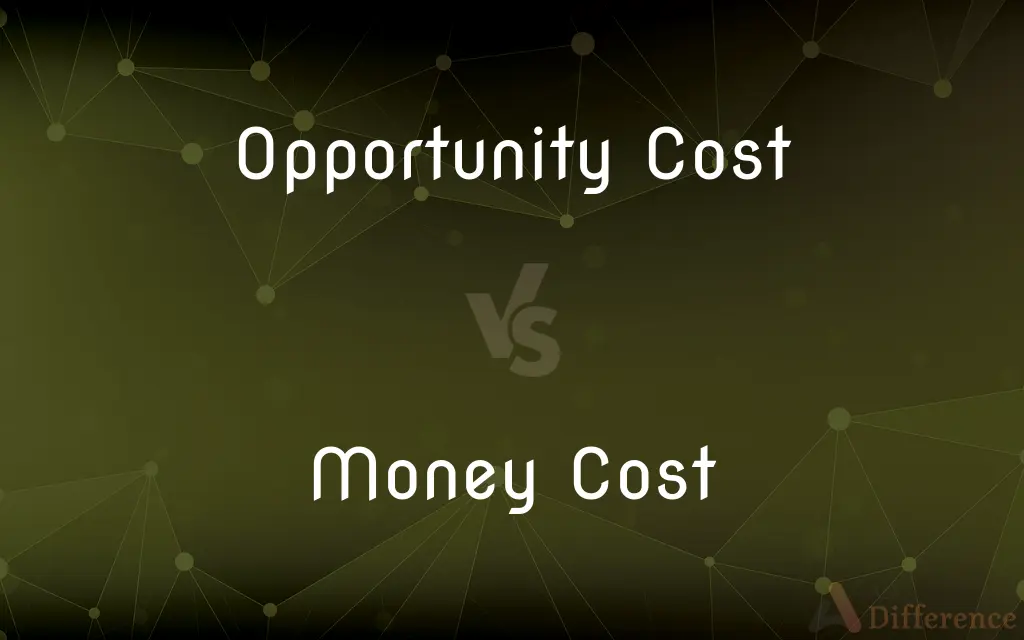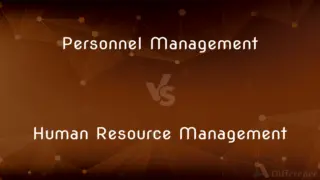Opportunity Cost vs. Money Cost — What's the Difference?
By Tayyaba Rehman — Published on October 12, 2023
Opportunity Cost signifies the cost of forgone alternatives, while Money Cost refers to the explicit financial expenditure incurred. Both evaluate costs differently in economic analyses.

Difference Between Opportunity Cost and Money Cost
Table of Contents
ADVERTISEMENT
Key Differences
Opportunity Cost and Money Cost are essential yet distinct concepts in economics and financial planning, each providing different lenses to assess cost implications in decision-making scenarios. Opportunity Cost pertains to the cost of forgoing the next best alternative when making a decision. It does not involve a direct exchange of money but represents a cost in terms of lost opportunities. In contrast, Money Cost pertains directly to the actual amount of money spent or to be spent on a specific choice or decision, illustrating the tangible financial expenditures associated with it.
In evaluating choices, Opportunity Cost encourages individuals and entities to consider what they are potentially missing out on when choosing one alternative over another. It’s not about the money spent, but about the benefits that could have been obtained from choosing the next best alternative. Money Cost, however, provides a clear, tangible measurement of what is being spent on a particular choice, offering a straightforward financial perspective on decision-making and allowing for easy numerical comparisons between alternatives.
Understanding Opportunity Cost is critical in strategic decision-making since it provides a framework to assess the unseen cost related to forgone benefits that might have been accrued from alternative options. It allows economists and decision-makers to weigh the unseen in their analyses. Money Cost, conversely, enables a grounded understanding of explicit financial outflows related to a decision, providing a concrete figure that can be analyzed, budgeted for, and compared directly to other potential expenditures.
Analyzing Opportunity Cost requires considering the benefits associated with forgone alternatives, and this concept permeates various economic and business decisions, contributing to a comprehensive assessment of decision-making scenarios. Alternatively, Money Cost is crucial when assessing the explicit financial viability of a choice, as it provides a definitive figure that can be directly tabulated and analyzed, thereby anchoring decisions with a clear financial parameter and allowing for assessments based on budget and cash flow.
Opportunity Cost and Money Cost provide varied perspectives and are often considered together in decision-making to garner a holistic view of the costs involved - both seen and unseen. While Opportunity Cost nudges decision-makers to contemplate what they are potentially missing, Money Cost keeps the analysis grounded by showcasing the explicit financial implications, thereby furnishing a comprehensive cost analysis.
ADVERTISEMENT
Comparison Chart
Nature
Implicit, intangible
Explicit, tangible
Involvement of Money
No direct money spent
Direct financial expenditure
Evaluation
Forgone benefits of alternatives
Actual monetary costs
Application
Strategic decision-making
Budgeting and financial analysis
Measurement
Subjective, can be qualitative
Objective, strictly quantitative
Compare with Definitions
Opportunity Cost
A measure of forgone alternative benefits.
Buying machinery presented the Opportunity Cost of technological upgrades.
Money Cost
Direct monetary expenditure associated with a decision.
Upgrading software systems implied a significant Money Cost.
Opportunity Cost
Value of benefits missed from alternative choices.
Going on vacation has the Opportunity Cost of saving that money.
Money Cost
Explicit monetary expense of a choice.
The Money Cost of hiring new staff included salaries and benefits.
Opportunity Cost
Implicit cost of forgoing alternatives.
Pursuing a bachelor's degree carried the Opportunity Cost of four years' work experience.
Money Cost
The tangible expenditure incurred for a choice.
The Money Cost of the laptop was $1,200.
Opportunity Cost
Cost of the next best alternative forgone.
Choosing to invest in stocks had an Opportunity Cost of the interest from a savings account.
Money Cost
Actual financial outlay related to a decision.
Building a new factory involved a substantial Money Cost.
Opportunity Cost
The loss of potential gain from other alternatives.
Allocating budget to marketing bore the Opportunity Cost of product development.
Money Cost
The clear financial cost of an action or decision.
Attending the conference represented a Money Cost for registration and travel.
Common Curiosities
What is Money Cost?
Money Cost refers to the actual, explicit financial expenditure incurred when making a decision.
How does Opportunity Cost differ from Money Cost?
Opportunity Cost is the cost of forgone alternatives, while Money Cost is the explicit monetary expenditure.
Can Opportunity Cost involve financial metrics?
Yes, Opportunity Cost can be quantified using potential financial gains from forgone alternatives.
Is Money Cost always tangible and measurable?
Yes, Money Cost involves actual financial expenditures, making it tangible and measurable.
How is Opportunity Cost utilized in decision-making?
Opportunity Cost is used to evaluate the unseen costs related to benefits missed from forgone alternatives.
What does Opportunity Cost represent?
Opportunity Cost represents the value of the best alternative forgone when making a decision.
Share Your Discovery

Previous Comparison
Personnel Management vs. Human Resource Management
Next Comparison
Private Trust vs. Public TrustAuthor Spotlight
Written by
Tayyaba RehmanTayyaba Rehman is a distinguished writer, currently serving as a primary contributor to askdifference.com. As a researcher in semantics and etymology, Tayyaba's passion for the complexity of languages and their distinctions has found a perfect home on the platform. Tayyaba delves into the intricacies of language, distinguishing between commonly confused words and phrases, thereby providing clarity for readers worldwide.
















































